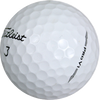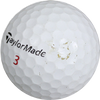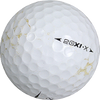How Do Used Golf Balls Perform vs New?
Spoiler Alert: Almost Exactly The Same
Some people are skeptical about the performance of golf balls that have spent time underwater. A lot of people have done testing on this – both in labs and with golfers on the course – and the results are always consistent. Lab tests, including our own, show little or no loss in yardage compared to new balls, and most golfers report no appreciable difference in play.
But most of this research is based on tests of mint-quality used golf balls pulled from water hazards with no understanding of how much time each ball spent underwater.
Does length of Time Underwater Matter?
Great question, and you’d think it must at some point, right? But how much time before a ball's performance is significantly changed? We decided to try to answer that question by being the first to commission a University-run, independent research study to find out. The goal? To compare the performance of brand new balls with balls that have spent 1-month, 3-months* and 5-months at the bottom of a real, live golf course pond. Here’s a quick summary of how the researcher – Thomas Raffel, Ph.D. of Michigan’s Oakland University – ran the study.
* 3-months underwater is an important threshold for us. Since we typically dive courses twice a year or more, the average used ball spends an average of three months or less underwater.
The Research
Dr. Raffel bought a bunch of brand new 2016 Titleist Pro V1s (ouch). He held on to some  of them, and sank the rest in cages at the bottom of a 5-foot deep pond on the Oakland University Golf Course. He left one cage submerged for a month before pulling it out.
of them, and sank the rest in cages at the bottom of a 5-foot deep pond on the Oakland University Golf Course. He left one cage submerged for a month before pulling it out.
He left a second cage for three months, and then a third for 5 months. The new balls and 'pond-balls' were all sent to Golf Laboratories – a well-known and respected independent testing facility in San Diego, California. They have a state-of-the art, computer-controlled robot player (check it out) which can hit a ball almost exactly the same over and over again. The robot hit all the new and used Pro V1s with a TaylorMade R7 425 driver. The robot was set to the parameters of an “Average Golfer” with a driver swing speed of 94 MPH. Then we measured distance to landing point, total distance with roll, spin, ball speed and overall consistency of flight and dispersion (how close they all ended up to each other after carry and roll). So, what did we find out?
The Results
All three groups of submerged golf balls performed almost exactly the same as the new ones. That’s right. Almost identically. You can see the data for yourself below. This research will also be published by Oakland University sometime in 2018. Note that since the three groups of pond balls were tested on different days in different weather and atmospheric conditions (which impact performance) each set of pond balls was tested against its own set of new "control" balls on the same day.
| DRIVER TEST: New vs. 1 Month in Pond | New Balls | 1 Month in Pond |
|---|---|---|
| Average Ball Speed - MPH** | 140.4 | 140.3 |
| Average Carry - Yards | 225.6 | 224.4 (- 1.2) |
| Average Total Distance - Yards with Roll | 251.2 | 248.7 (- 2.5) |
| Average Spin Rate - RPMs* | 3019 | 3008 |
| DRIVER TEST: New vs. 3 Months in Pond | New Balls | 3 Months in Pond |
|---|---|---|
| Average Ball Speed - MPH** | 138.8 | 138.7 |
| Average Carry - Yards | 221.7 | 221.2 (-.5) |
| Average Total Distance - Yards with Roll | 242.4 | 242.6 (-.2) |
| Average Spin Rate - RPMs* | 3180 | 3225 |
| DRIVER TEST: New vs. 5 Month in Pond | New Balls | 5 Months in Pond |
|---|---|---|
| Average Ball Speed - MPH** | 136.6 | 136.7 |
| Average Carry - Yards | 216.0 | 215.4 (- .6) |
| Average Total Distance - Yards with Roll | 237.4 | 236.4 (- 1) |
| Average Spin Rate - RPMs* | 3060 | 3072 |
Consistency of Flight and Dispersion
Golf Laboratories used Trackman technology to collect the data shown above. Trackman also generated the maps below which track the flight paths of all balls, as well as their final dispersion - how close they all ended up to each other after carry and roll. What this data shows is that, once again, the performance of all the balls - the new balls, those submerged for 1 month, 3 months and 5 months is nearly identical.
Flight Paths: New Balls and Balls That Spent 1 Month in the Pond

Flight Paths: New Balls and Balls That Spent 3 Months in the Pond
Flight Paths: New Balls and Balls That Spent 5 Months in the Pond
Final Dispersion (stopping point): New Balls and Balls That Spent 1 Month in the Pond

Final Dispersion (stopping point): New Balls and Balls That Spent 3 Months in the Pond
Final Dispersion (stopping point): New Balls and Balls That Spent 5 Months in the Pond
So, What Does This Mean to You?
Here's the good news. Our divers on average dive a golf course 2 times a year (every 6 months). Even more if the course has a lot of play. That means the average used golf ball sits in water for about 3 months (and often way less). And the Oakland University research study shows that if a new golf ball sits in water for up to 5 months - and maybe longer - there is no discernible loss in distance or performance. Sweet!
Here’s the bad news. We still don't know how long a ball has to spend underwater before it shows a loss in performance. So, stayed tuned as we keep testing. Meanwhile stop paying tons more for new golf balls that don’t perform any better than used golf balls!
And remember, as far as we’re concerned the question has never been, “Are used golf balls as good as new?” The question is, “Is it worth paying twice as much for maybe 1% more distance?”
Want to Know How Golf Ball Construction Got This Good?
Read our fascinating - and pretty much true - illustrated History of the Golf Ball. Or better yet, buy some balls!







